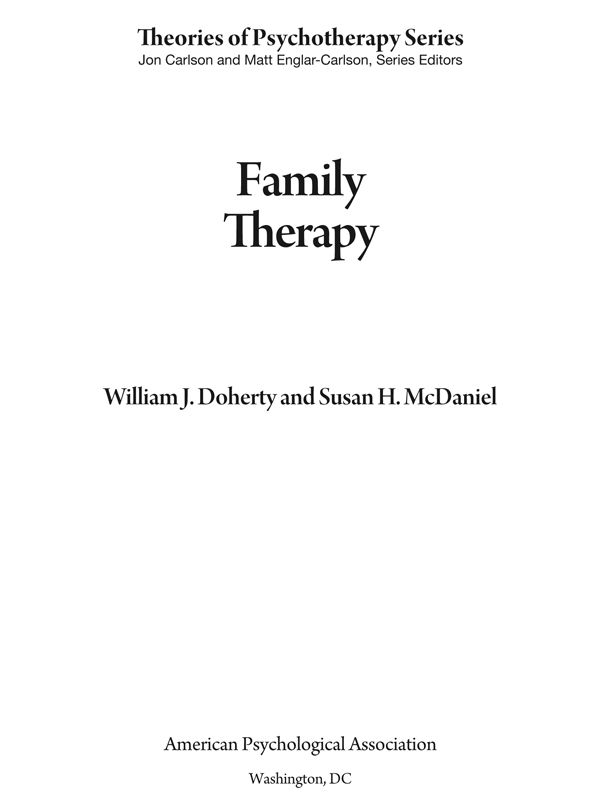
- •Isbn-10: 1-4338-0549-9
- •Introduction
- •The Palo Alto Team
- •Murray Bowen
- •Salvador Minuchin and Structural Family Therapy
- •Strategic Family Therapy
- •Solution-Oriented Therapy
- •Narrative Therapy
- •Psychoeducation Family Therapy and Medical Family Therapy
- •Multisystemic Therapy
- •Multidimensional Family Therapy
- •Figure 3.1
- •Figure 3.1 (Continued)
- •The Patient’s Symptom as a Function of Unresolved Family Issues
- •Figure 4.1
- •The “Patient” in Family Therapy
- •Two Against One: Triangulation and Intergenerational Coalitions
- •The Pursuer–Distancer Dance
- •Collaboration and the Role of the Larger System
- •The Role of the Therapist
- •The Role of the Patient and Family
- •Goal Setting
- •Enactment
- •Circular Questions
- •Externalizing the Problem
- •Family Sculpting
- •Positively Connoting the Resistance to Change
- •Genograms and Time Lines
- •Building on Family Strengths
- •Figure 4.2
- •Family Psychoeducation for Schizophrenia
- •Adolescent Conduct Disorders
- •Adolescent Substance Abuse
- •Childhood Behavioral and Emotional Disorders
- •Anorexia Nervosa in Adolescence
- •Alcohol Abuse in Adults
- •Interventions With Physical Disorders
- •Ideas and techniques that cut across models of family therapy

Theories of Psychotherapy Series
Cognitive–Behavioral Therapy
Michelle G. Craske
Existential–Humanistic Therapy
Kirk J. Schneider and Orah T. Krug
Family Therapy
William J. Doherty and Susan H. McDaniel
Feminist Therapy
Laura S. Brown
Relational–Cultural Therapy
Judith V. Jordan

Copyright © 2010 by the American Psychological Association. All rights reserved. Except as permitted under the United States Copyright Act of 1976, no part of this publication may be reproduced or distributed in any form or by any means, including, but not limited to, the process of scanning and digitization, or stored in a database or retrieval system, without the prior written permission of the publisher.
Electronic edition published 2012.
ISBN: 978-1-4338-0834-0 (electronic edition).
Published by
American Psychological Association
750 First Street, NE
Washington, DC 20002
www.apa.org
To order
APA Order Department
P.O. Box 92984
Washington, DC 20090-2984
Tel: (800) 374-2721;
Direct: (202) 336-5510
Fax: (202) 336-5502;
TDD/TTY: (202) 336-6123
Online: www.apa.org/books/
E-mail: order@apa.org
In the U.K., Europe, Africa, and the Middle East,
copies may be ordered from
American Psychological Association
3 Henrietta Street
Covent Garden, London
WC2E 8LU England
Typeset in Minion by Shepherd Inc., Dubuque, IA
Printer: Edwards Brothers, Ann Arbor, MI
Cover Designer: Minker Design, Sarasota, FL
Cover Art: Lily Rising, 2005, oil and mixed media on panel in craquelure frame, by Betsy Bauer.
The opinions and statements published are the responsibility of the authors, and such opinions and statements do not necessarily represent the policies of the American Psychological Association.
Library of Congress Cataloging-in-Publication Data
Doherty, William J. (William Joseph), 1945-
Family therapy / William J. Doherty and Susan H. McDaniel.
p. cm.
Includes bibliographical references and index.
ISBN-13: 978-1-4338-0549-3
Isbn-10: 1-4338-0549-9
1. Family psychotherapy. I. McDaniel, Susan H. II. American Psychological Association. III. Title.
RC488.5.D628 2010
616.89'156—dc22
2009018746
British Library Cataloguing-in-Publication Data
A CIP record is available from the British Library.
Printed in the United States of America
First Edition
To our students—of all disciplines
Contents
Series Preface
1. Introduction
2. History
3. Theory
4. The Therapy Process
5. Evaluation
6. Future Developments
7. Summary
Glossary of Key Terms
References
About the Authors
Series Preface
Some might argue that in the contemporary clinical practice of psychotherapy, evidence-based intervention and effective outcome have overshadowed theory in importance. Maybe. But, as editors of this series, we don’t propose to take up that controversy here. We do know that psychotherapists adopt and practice according to one theory or another because their experience, and decades of good evidence, suggests that having a sound theory of psychotherapy leads to greater therapeutic success. Still, the role of theory in the helping process can be hard to explain. This narrative about solving problems helps convey theory’s importance:
Aesop tells the fable of the sun and wind having a contest to decide who was the most powerful. From above the earth, they spotted a man walking down the street, and the wind said that he bet he could get his coat off. The sun agreed to the contest. The wind blew and the man held on tightly to his coat. The more the wind blew, the tighter he held. The sun said it was his turn. He put all of his energy into creating warm sunshine and soon the man took off his coat.
What does a competition between the sun and the wind to remove a man’s coat have to do with theories of psychotherapy? We think this deceptively simple story highlights the importance of theory as the precursor to any effective intervention—and hence to a favorable outcome. Without a guiding theory, we might treat the symptom without understanding the role of the individual. Or we might create power conflicts with our clients and not understand that, at times, indirect means of helping (sunshine) are often as effective—if not more so—than direct ones (wind). In the absence of theory, we might lose track of the treatment focus and instead get caught up in, for example, social correctness and not wanting to do something that looks too simple.
What exactly is theory? The APA Dictionary of Psychology defines theory as “a principle or body of interrelated principles that purports to explain or predict a number of interrelated phenomena.” In psychotherapy, a theory is a set of principles used to explain human thought and behavior, including what causes people to change. In practice, a theory creates the goals of therapy and specifies how to pursue them. Haley (1997) noted that a theory of psychotherapy ought to be simple enough for the average therapist to understand but comprehensive enough to account for a wide range of eventualities. Furthermore, a theory guides action toward successful outcomes while generating hope in both the therapist and client that recovery is possible.
Theory is the compass that allows psychotherapists to navigate the vast territory of clinical practice. In the same ways that navigational tools have been modified to adapt to advances in thinking and ever-expanding territories to explore, theories of psychotherapy have changed over time. The different schools of theories are commonly referred to as waves, the first wave being psychodynamic theories (i.e., Adlerian, psychoanalytic), the second wave learning theories (i.e., behavioral, cognitive–behavioral), the third wave humanistic theories (person-centered, gestalt, existential), the fourth wave feminist and multicultural theories, and the fifth wave postmodern and constructivist theories. In many ways, these waves represent how psychotherapy has adapted and responded to changes in psychology, society, and epistemology as well as to changes in the nature of psychotherapy itself. Psychotherapy and the theories that guide it are dynamic and responsive. The wide variety of theories is also testament to the different ways in which the same human behavior can be conceptualized (Frew & Spiegler, 2008).
It is with these two concepts in mind—the central importance of theory and the natural evolution of theoretical thinking—that we developed the APA Theories of Psychotherapy Series. Both of us are thoroughly fascinated by theory and the range of complex ideas that drive each model. As university faculty members who teach courses on the theories of psychotherapy, we wanted to create learning materials that not only highlight the essence of the major theories for professionals and professionals in training but also clearly bring the reader up-to-date on the current status of the models. Often in books on theory, the biography of the original theorist overshadows the evolution of the model. In contrast, our intent was to highlight the contemporary uses of the theories as well as their history and context.
As this project began, we faced two immediate decisions: which theories to address and who best to present them. We looked at graduate-level theories of psychotherapy courses to see which theories are being taught, and we explored popular scholarly books, articles, and conferences to determine which theories draw the most interest. We then developed a dream list of authors from among the best minds in contemporary theoretical practice. Each author is one of the leading proponents of that approach as well as a knowledgeable practitioner. We asked each author to review the core constructs of the theory, bring the theory into the modern sphere of clinical practice by looking at it through a context of evidence-based practice, and clearly illustrate how the theory looks in action.
There are 24 titles planned for the series. Each title can stand alone or can be put together with a few other titles to create materials for a course in psychotherapy theories. This option allows instructors to create a course featuring the approaches they believe are the most salient today. To support this end, APA Books has also developed a DVD for each of the approaches that demonstrates the theory in practice with a real client. Some of the DVDs show therapy over six sessions. Contact APA Books for a complete list of available DVD programs (http://www.apa.org/pubs/videos/).
In this book, Drs. Doherty and McDaniel clearly present family systems theory and practice. Because people do not exist alone, it is necessary to understand numerous social and cultural dynamics and how they affect individuals. This approach shows how to understand the context and systems dynamics that affect clients as well as how to change those that are harmful. Although the title of this monograph is “family therapy,” the model also applies to working with individual clients. Drs. McDaniel and Doherty draw upon their vast experience as practicing psychotherapists and researchers to provide a clear and concise description of family theory and practice.
—John Carlson and Matt Englar-Carlson
REFERENCES
Frew, J., & Spiegler, M. (2008). Contemporary psychotherapies for a diverse world. Boston: Lahaska Press.
Haley, J. (1997). Leaving home: The therapy of disturbed young people. New York: Routledge.
![]()
